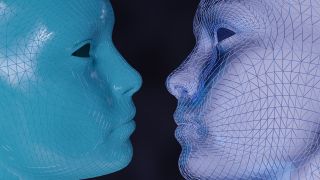Artificial Intelligence
Emotions Into Technology: What's Lost in Translation?
Transferring emotions to technology risks reductionism and imprinting of biases.
Posted August 30, 2023 Reviewed by Gary Drevitch
Key points
- While our knowledge of emotions has advanced, we are still discovering what they are.
- Our understanding of emotions will be skewed by culture, biases, and the reductionism of this understanding.
- Emoticons are one basic way we have imbued technology with emotions.
- Transferring our understanding of emotions into tech and AI also risks transferring our biases.

Emoticons help us communicate digitally by allowing us to display certain emotions. Emotions are made to be displayed; signaling our feelings to others is one of their important functions. However, they are believed to aid in a range of other important functions, too, most of which are not conveyed in an emoticon, such as motivating behavior, and directing attention to stimuli. Could the reduction of what an emotion is through its digital variant in emoticons be indicative of a wider reductionism occurring as humans become more invested in technology and AI?
Emoticons convey one of the crucial aspects of emotions: a facial display :) Emotions are also believed to have evolved to be revealing; faking them is of course possible, but displaying emotions through emoticons makes them significantly easier to fake.
Pioneers in the field of emotion research such as Paul Ekman granted a great deal of significance to this aspect of emotions, with Darwin before him having written on the relationship between emotions and facial expressions.
Emotions are much more than facial expressions, though. Emotions are complex to the point that there is as of yet no universally agreed upon definition of what exactly an emotion is (or isn’t). Trends to this end do exist (nicely summarized here) – of the common delineations being emotions are 1) feelings, 2) evaluations, and 3) motivations.
However, there is still a great deal of discussion on this topic, to the point that some researchers have questioned the stability of the term, while others have suggested it is too difficult to study because of the range of definitions of what it is. Soberly, Dukes et al (2021) remind us that while other constructs have no universally agreed upon definition — such as intelligence, culture, and life — we are still able to research them scientifically, and with betterment to our understanding of them, and people's lives as a result.
Even when considering only the facial display aspect of an emotion, does an emoticon do the same job as an actual face? Some research suggests it might, yet it seems premature to conclude they are one and the same. As an example, it is now well established that emotions can be contagious, yet there is as of yet no evidence that emoticons follow suit.

Bias Transference
The issue might become a little more critical in light of ongoing attempts to program emotions into AI. As has already been witnessed in the transference of certain biases into AI, we are transferring our understandings of complex processes that are steeped in subjectivity and more.
This would be par for the course of the broader trend of psychology being heavily skewed towards WEIRD (Western, educated, industrialized, rich and democratic) psychologists and their subset of values and understandings. This has already been reflected in the initial emoji keyboard being skewed towards certain races, ethnicities, cultures, physical compositions, sexualities, and religions, while others were initially absent. While the emoji keyboard has since been updated to be more representative, and continues to be updated to this end, this reflects the underlying idea of certain realities being imprinted on our tech, while others are not.
Critically, most researchers agree that culture can play a significant role in the realization of emotions, so that emotions are not all the same between cultures. Updating an AI-imbued concept of emotions might not be as straightforward as updating an emoji keyboard.
While this is something of a usual factor in the pipeline of a subjective creator and their creation, where the stakes are raised, and perhaps even qualitatively different, when it comes to AI, is the potential power held by the creation, and the possibility of AI becoming self-sustaining. Of course there is then an inverse worry: What if AI gains power, self-sustenance, and even free will, but without sentience (i.e. the ability to feel)? Following this line of thinking, an argument can be made that it is imperative that scientists get the transfer of emotions to AI correct.
Regardless, whether the goal is preventing biases in our understanding of emotions, or ensuring that we do not narrow the full function of emotions that are imbued in AI, or working towards making sure AI is sentient, deferring to caution seems like a wise frame to employ, at least until we have a fuller and surer understanding of emotions and their many functions.
References
Dukes, D., Abrams, K., Adolphs, R., Ahmed, M. E., Beatty, A., Berridge, K. C., Broomhall, S., Brosch, T., Campos, J. J., Clay, Z., Clément, F., Cunningham, W. A., Damasio, A., Damasio, H., D’Arms, J., Davidson, J. W., de Gelder, B., Deonna, J., de Sousa, R., … Sander, D. (2021). The Rise of Affectivism. In Nature Human Behaviour (Vol. 5, Issue 7). https://doi.org/10.1038/s41562-021-01130-8
Obermeyer, Z., Powers, B., Vogeli, C., & Mullainathan, S. (2019). Dissecting racial bias in an algorithm used to manage the health of populations. Science (New York, N.Y.), 366(6464), 447–453. https://doi.org/10.1126/science.aax2342
Pfeifer, V. A., Armstrong, E. L., & Lai, V. T. (2022). Do all facial emojis communicate emotion? the impact of facial emojis on perceived sender emotion and text processing. Computers in Human Behavior, 126, 107016. https://doi.org/10.1016/j.chb.2021.107016


